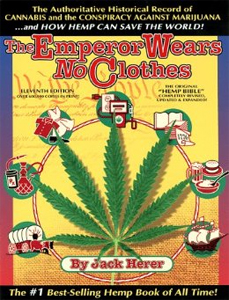
The Emperor Wears No Clothes
by Jack Herer
The Mystic Philosophers
Cannabis legend and consumption are fundamental aspects of many of the world’s great religions. For example:
Shintoism (Japan)
Cannabis was used for the binding together of married couples, to drive away evil spirits, and was thought to create laughter and happiness in marriage.
Hinduism (India)
The God Shiva is said “to have brought cannabis from the Himalayas for human enjoyment and enlightenment.” The Sadhu Priests travel throughout India and the world sharing “chillum” pipes filled with cannabis, sometimes blended with other substances. In the Bhagavad-Gita, Krishna states, “I am the healing herb” (Ch.9:16), while the Bhagarat-Purana Fifth Canto describes hashish in explicitly sexual terms.
Buddhism (Tibet, India and China)
From the 5th century B.C. on ritually used cannabis; initiation rites and mystical experiences were (are ) common in many Chinese Buddhist Sects. Some Tibetan Buddhists and lamas (priests) consider cannabis their most holy plant. Many Buddhist traditions, writings, and beliefs indicate that “Siddhartha” (the Buddha) himself, used and ate nothing but hemp and its seeds for six years prior to announcing (discovering) his truths and becoming the Buddha (Four Noble Truths, the Eightfold Path).
Zoroastrians or Magi (Persia, circa 8th to 7th Centuries B.C. to 3rd to 4th Centuries A.D.)
It is widely believed by many Christian scholars, commentators, etc., that the three “Magi” or Wise Men who attended the birth of Christ were cult references to the Zoroastrians. The Zoroastrian religion was based (at least on the surface) on the entire cannabis plant, the chief religious sacrament of its priest class, and its most important medicine, (e.g., obstetrics, incense rites, anointing and christening oils), as well as lighting or fire oils in their secular world. The word “magic” is generally considered derived from the Zoroastrians “Magi.”
Other Cultures
The ESSENES (ancient Israeli sect of extreme Hebrewites, approx. 200 B.C. to 73 A.D.) used hemp medicinally, as did the:
THERAPUTEA (Egypt), from whom we get the term “therapeutic.” Both are believed by some scholars to be disciples of, or in a brotherhood with, the priests/magicians of the Zoroastrians.
EARLY JEWS As part of their holy Friday night services in the Temple of Solomon, 60-80,000men ritually passed around and inhaled 20,000 incense burners filled with kanabosom (cannabis), before returning home for the largest meal of the week (munchies?).
SUFIS OF ISLAM (Middle East) – Moslem “mystical” priests who have taught, used and extolled cannabis for divine revelation, insight and oneness with Allah, for at least the last 1,000 years. Many Moslem and world scholars believe the mysticism of the Sufi Priests was actually that of the Zoroastrians who survived Moslem conquests of the 7th and 8th Centuries A.D. and subsequent conversion (change your religion and give up liquor or be beheaded).
COPTIC CHRISTIAN (Egypt/Ethiopia) – Some sects believe the sacred ”green herb of the field” in the Bible (“I will raise up for them a plant of renown, and they shall be no more consumed with hunger in the land, neither bear the shame of the heathen any more” Ezekiel 34:29) and the Biblical secret incenses, sweet incenses and anointing oils to be cannabis.
The BANTUS (Africa) – had secret Dagga Cults,* societies which restricted cannabis use to the ruling men. The Pygmies, Zulus and Hottentots all found it an indispensable medication for cramps, epilepsy and gout, and as a religious sacrament.
*These “Dagga” cults believed Holy Cannabis was brought to Earth by the Gods, in particular from the “Two Dog Star” system that we call Sirius A and B. “Dagga” literally means “cannabis.” Interestingly, the surviving Indo-European word for the plant can also be read as “canna,” “reed” and “bi,” “two,” as well as “canna,” as in canine; and “bis,” meaning two (bi) “Two Dogs.”

